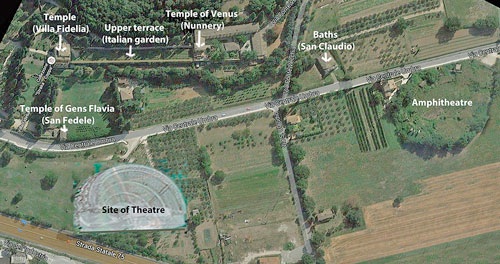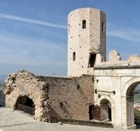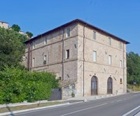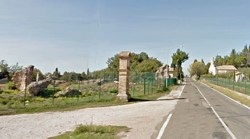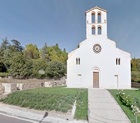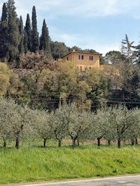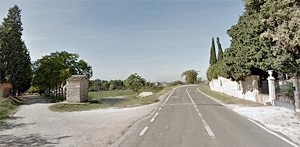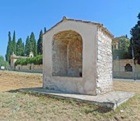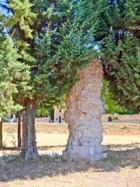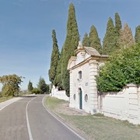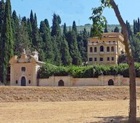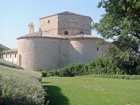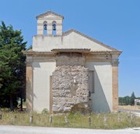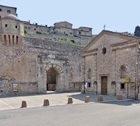Aerial view of the site of the Roman sanctuary
This walk concentrates on the elements of the important
Roman sanctuary that was established outside the city walls in the late 1st century BC. It begins at
Porta Venere (also visited in Walk I), which quite possibly articulated a processional route from the city to the sanctuary (from the right in the aerial view above, along what is now Via Centrale Umbra). The walk then takes you past a number of elements of this sanctuary, which are marked with an asterisk below and described on the page reached from the link above.
Walk down to the busy Via Centrale Umbra to the
“Osteriaccia” (hostel for pilgrims). Cross Via Centrale Umbra and turn right along it.
Continue to the fenced site of the amphitheatre*, with
San Claudio (occasionally open for weddings or concerts) slightly beyond, on the opposite side of the road. There is a display to the left of the church that describes the excavations here that uncovered (
inter alia) the remains of the baths* that (like the amphitheatre) formed part of the sanctuary.
The next turning on the right (Via Porta Fontevecchia) leads to the part of the original Villa Fidelia that now belongs to the Suore Francescane Piccolo San Damiano. This building stands at the extreme right of a terrace* that formed part of the Roman sanctuary, on the site of a temple* dedicated to Venus. (Unfortunately, the nunnery cannot be visited).
Continue ahead to the start of the wall of Villa Fidelia (below):
-
✴The tabernacle on the left probably stands on the site of a church dedicated to St Felix that was documented in 1406. (It is described in the page on San Fedele - see the link below).
-
✴The only surviving vestige of the
Roman theatre* is almost hidden in the trees further along this side street, on the left.
Return to Via Centrale Umbra and continue past
San Fedele, which formed the private chapel of the Villa Fidelia in the 18th century. It probably stands on the foundations of a temple* that was built in ca. 335 in honour of the
gens Flavia, the family of the Emperor Constantine.
The entrance to the grounds of
Villa Fidelia is slightly further along on the right. This villa took on its present form in around 1930, after the original villa (now the nunnery of the Suore Francescane Piccolo San Damiano - above) had been sold. It stands at the extreme left of the terrace* mentioned above, on the probable site of a temple* that was the twin of the Temple of Venus to the right.
That concludes the walk through the Roman sanctuary, but you might want make a detour of about an hour to see two other interesting churches (although both are closed). If so, continue along Via Centrale Umbra.
The
Chiesa Tonda is on the right, just after the city limit. The complex is now privately owned, and the adjacent convent has been adapted for weddings and similar functions. It is usually possible to walk around it, although the church is deconsecrated and closed.
Return along Via Centrale Umbra and take the first turning on the right, which takes you under the motorway, and then turn left along Via dell'Industria (which runs parallel to the motorway). Take the next right (Via San Felice); then the fourth turning on the left, Via del Lavoro; turn right at the end along Via Gigliara; turn left at the end along Via Achille Grandi; and finally turn right at the end along Via del Mausoleo. This road goes under the railway line and then (confusingly) merges with another road of the same name that joins it from the left.
Continue straight ahead along the merged road to the church of
Santa Maria del Mausoleo (at the junction with Via Cinque Vie and the city limit).
Retrace your steps but now take the right branch of Via del Mausoleo, which runs parallel to the railway line. Turn left (and under the railway line) at Via Guerrino Bonci and continue to Porta Urbica (visited in Walk I), where the walk ends.
